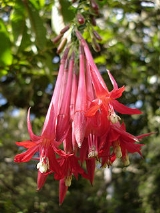
Fuchsia boliviana
Encyclopedia
Fuchsia boliviana is a species of Fuchsia
native to southern Peru
, Bolivia
and northern Argentina
. It is a medium evergreen shrub, growing to 2–4 m tall, rarely to 6 m, with a spreading, open habit. It has large, hairy mid-green leaves and red petioles
. It has large drooping corymbs
up to 20 cm long born e in late summer and autumn of scarlet red flowers with the individual flowers 3–7 cm long. After flowering it bears small red-purple, edible fruit 10–26 mm long.
Fuchsia boliviana is widely grown in shade or part-shade in cooler, subtropical climates. Plants require protection from direct sun and temperatures exceeding 40 °C. The plants are hardy to about -4 °C for short periods. Propagation is by seed or cuttings.
Fuchsia
Fuchsia is a genus of flowering plants that consists mostly of shrubs or small trees. The first, Fuchsia triphylla, was discovered on the Caribbean island of Hispaniola in 1703 by the French Minim monk and botanist, Charles Plumier...
native to southern Peru
Peru
Peru , officially the Republic of Peru , is a country in western South America. It is bordered on the north by Ecuador and Colombia, on the east by Brazil, on the southeast by Bolivia, on the south by Chile, and on the west by the Pacific Ocean....
, Bolivia
Bolivia
Bolivia officially known as Plurinational State of Bolivia , is a landlocked country in central South America. It is the poorest country in South America...
and northern Argentina
Argentina
Argentina , officially the Argentine Republic , is the second largest country in South America by land area, after Brazil. It is constituted as a federation of 23 provinces and an autonomous city, Buenos Aires...
. It is a medium evergreen shrub, growing to 2–4 m tall, rarely to 6 m, with a spreading, open habit. It has large, hairy mid-green leaves and red petioles
Petiole (botany)
In botany, the petiole is the stalk attaching the leaf blade to the stem. The petiole usually has the same internal structure as the stem. Outgrowths appearing on each side of the petiole are called stipules. Leaves lacking a petiole are called sessile, or clasping when they partly surround the...
. It has large drooping corymbs
Panicle
A panicle is a compound raceme, a loose, much-branched indeterminate inflorescence with pedicellate flowers attached along the secondary branches; in other words, a branched cluster of flowers in which the branches are racemes....
up to 20 cm long born e in late summer and autumn of scarlet red flowers with the individual flowers 3–7 cm long. After flowering it bears small red-purple, edible fruit 10–26 mm long.
Fuchsia boliviana is widely grown in shade or part-shade in cooler, subtropical climates. Plants require protection from direct sun and temperatures exceeding 40 °C. The plants are hardy to about -4 °C for short periods. Propagation is by seed or cuttings.

